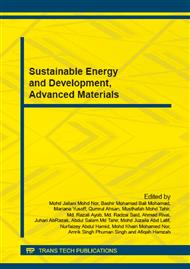p.3
p.9
p.15
p.20
p.26
p.32
p.38
p.44
Effect of Curing Conditions on the Mechanical Properties of Fly Ash-Based Geopolymer without Sodium Silicate Solution
Abstract:
Geopolymer is associated with the alkali activation of materials rich in Si and Al, and alkali activator such as sodium hydroxide is used for the dissolution of raw material with the addition of sodium silicate solution to increase the dissolution process. However, the trend of strength development of geopolymer using sodium hydroxide alone is not well established. This paper presents an evaluation on compressive strength of fly ash–based geopolymer by varying curing time with respect to different curing temperature using sodium hydroxide as the only activator. The samples were cured at room temperature and at an elevated temperature (60°C). Further analysis on the microstructure of geopolymer products cured at 60°C was carried out using Field Emission Scanning Microscopy (FESEM). It can be observed that the compressive strength increased as the curing time increased when cured at room temperature; whereas at elevated temperature, the strength increased up to a maximum 65.28 MPa at 14 days but gradually decreased at longer curing time. Better compressive strength can be obtained when the geopolymer was cured at an elevated temperature compared to curing at room temperature.
Info:
Periodical:
Pages:
15-19
Citation:
Online since:
November 2014
Keywords:
Price:
Сopyright:
© 2015 Trans Tech Publications Ltd. All Rights Reserved
Share:
Citation:


